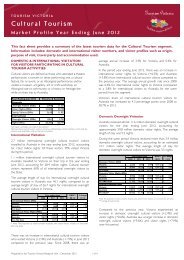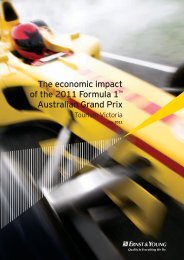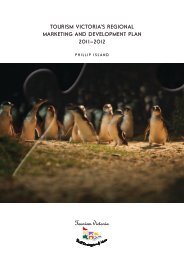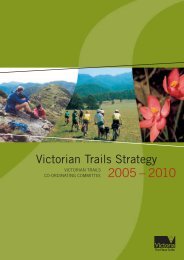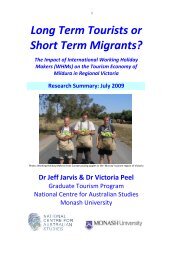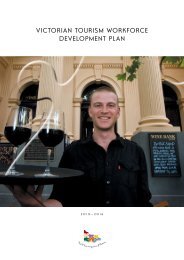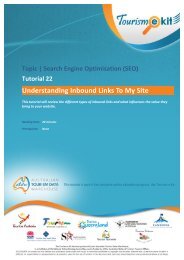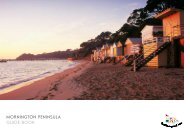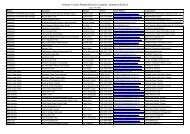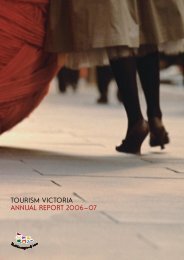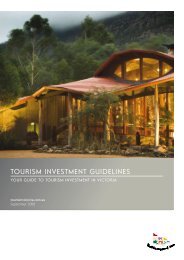Crisis Communications Handbook for Regional ... - Tourism Victoria
Crisis Communications Handbook for Regional ... - Tourism Victoria
Crisis Communications Handbook for Regional ... - Tourism Victoria
Create successful ePaper yourself
Turn your PDF publications into a flip-book with our unique Google optimized e-Paper software.
Other TRRG actions include:<br />
• A further In<strong>for</strong>mation Request <strong>for</strong>m is sent to tourism operators and accommodation providers to gauge<br />
ongoing impact<br />
• Members meet with tourism providers and local tourism associations, either individually or in small groups,<br />
to get direct feedback<br />
• Advice is offered to directly affected operators regarding alternate tourism offerings and the<br />
assistance available<br />
• Potential costings are developed <strong>for</strong> a short-to-medium term marketing and communications ef<strong>for</strong>t<br />
• Survey results are collated into an Impact Report <strong>for</strong> use in discussions with key stakeholders regarding<br />
possible assistance<br />
• <strong>Crisis</strong> communications experts are engaged to assist with ef<strong>for</strong>ts to communicate key messages to<br />
stakeholders, including Government and the media<br />
• Senior editorial personnel in the metropolitan media are briefed about the impact of the bloom on the<br />
region’s tourism sector and asked to assist in promoting unaffected areas and activities<br />
• TV programs such as Stateline, Getaway and Postcards are also approached<br />
• Selected journalists are invited to visit the region and experience first-hand what is still on offer<br />
• Media interviews are arranged with tourism providers to emphasise their determination to overcome<br />
the difficulties and to appeal directly to potential visitors to support the region<br />
• Ef<strong>for</strong>ts are made through Fact Sheets and briefings to educate observers about the causes of blue green<br />
algae and the long-term strategies (Future Directions and Action Plan) in place to minimise blooms<br />
• <strong>Regional</strong> marketing ef<strong>for</strong>ts continue to be reviewed and revised as necessary to reflect the key messages.<br />
Week Five<br />
The serious outbreak is into its second month with the bloom at varying levels across the Gippsland Lakes and<br />
Catchment. DSE is monitoring the situation extensively and providing regular internal and external updates, with<br />
a focus on emphasising safe areas <strong>for</strong> recreational water use.<br />
The metropolitan media has largely moved on to other stories and local media is concentrating on<br />
the economic impact of the natural disaster and the financial hardship being experienced by fishing<br />
and tourism businesses.<br />
Un<strong>for</strong>tunately, mainstream media interest is re-triggered by reports of a nine-year-old girl becoming ill while on<br />
holiday in the region. She is flown <strong>for</strong> treatment to the Royal Children’s Hospital and her parents speculate that<br />
blue green algae exposure may be to blame. All media cover the story extensively but it emerges within 24<br />
hours that the girl’s illness is not related to the bloom.<br />
While this fact is duly reported, it does not receive the same blanket treatment in the metropolitan media,<br />
causing considerable damage in terms of potential visitor perceptions regarding safety and the region’s desirability.<br />
CRISIS COMMUNICATIONS HANDBOOK FOR REGIONAL AND LOCAL TOURISM 59





